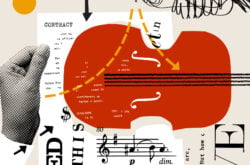Illustration: Filip Fröhlich
Ready to spread the word about your music?
You’ve found your sound, you’ve released a few songs, and you’re ready to take your music career to the next level—what you need to focus on now is promotion. This means booking more gigs, getting featured in the media, getting sync deals, and finding advocates who’ll help spread the word about your music. You can’t do all that without an EPK—well, you can, but it will take a lot more time and effort (not to mention, industry professionals won’t be very happy with you).
So what exactly is an EPK? Why do you need one? What does it have to include? Read on to find out the answers to all these questions and get ready to create your very own EPK to start promoting your music the right way.
What is an EPK?
“EPK” stands for “electronic press kit.” In essence, you can think of it as a resume for musicians.
Back in the day, musicians used to tell the press about their music by printing and mailing out physical kits. Later, that turned into emails with way too many attachments.
These days, the best way to present yourself as a musician is through a press kit that lives on a dedicated website—an EPK.
Why do you need an EPK?
An EPK will help you show decision makers in the music industry who you are, what you’ve accomplished so far, and why they should work with you.
The people you’ll send it to—media contacts, venue managers, music supervisors—don’t have time to browse the internet to learn about you. They receive hundreds of requests every single day, and the best way to get their attention is to make their job as easy as possible. An EPK allows you to package everything they need to know about you in a quick-to-read, visually appealing, and user-friendly format.
How to create an EPK (and what to include)
The best way to create an EPK that stands out from the crowd is to design a dedicated website or a page on your existing artist website. If it’s in your budget, you can hire a professional web developer. Otherwise, there are many great options for a do-it-yourself approach, such as Wix or Squarespace.
If you don’t want to create an EPK from scratch, there are also a few services out there that offer ready-to-use templates—all you have to do is fill in your information and upload your files. If you’re interested in this approach, check out Sonicbids, ReverbNation, or Bandzoogle.
Once you’ve decided how you’ll be creating your EPK, it’s time to think about what you’ll include in it. Below are the components that most industry professionals look for in an EPK.
1. Your music
Your music, of course, is the main attraction. It’s what will ultimately convince someone to write about you or work with you. That’s why you should place your music front and center in your EPK. Make a playlist with 2 – 3 of your most popular songs and embed it directly into the webpage—you want to make it as easy as possible for people to listen to your music without leaving your EPK website.
If you have any music videos, embed one or two of your best ones into your EPK as well. They’ll give the visitor a visual representation of your music and a better sense of who you are as an artist.
2. Biography
Include a short version of your musician bio. Remember that including your bio doesn’t just help the reader get to know you better; it’s also what they’ll use if they decide to write about you in the media. Make sure your bio is up to date and contains everything you would want potential fans and collaborators to know about you.
Your EPK should be quick-to-read and visually appealing, so don’t clutter it with the full version of your bio. Instead, create a link to another webpage where someone can find the full bio should they need more information about you.
3. Photos and album art
This is your chance to show off who you are, your personality, and your style. Your photos and album art will give people a sense of who is behind the music and help reinforce the ambience that your songs create.
Your photos and album art serve another very important purpose—if someone chooses to write about you in the media, these are the assets they’ll use. Think carefully about how you want to be presented in the media and choose 2 – 3 of your best photos. You can also link to a separate page with more photos or a place where people can download higher resolution versions and alternate sizes.
4. Your brand
Just like your photos and album art, the overall look and feel of your EPK should be representative of who you are as a musician. This means that your webpage should align with your brand and stay cohesive throughout.
You can do this by using your brand colors, font, and other prominent design elements. Wherever you have web copy, make sure it maintains the same tone and voice. Pay attention to the little things like consistent spacing and capitalization of titles.
An EPK that’s visually appealing and has no inconsistencies or errors will look much more professional and make a great first impression.
5. Press and testimonials
If you’ve already been featured in the media, be sure to show it off. Include a section in your EPK where you list the publications you’ve been featured in and pull a few quotes as a quick summary of what they had to say. When a contact from another publication views your EPK, this will act as proof that you’re someone worth writing about.
If you haven’t been featured anywhere just yet, it’s still possible to include a few positive testimonials. Think of someone you’ve worked with in the music industry—a producer, engineer, co-writer, photographer, etc—and ask them to say a few nice words about you. Any proof that you have people in your corner will go a long way in convincing someone to work with you.
6. Upcoming shows
As a musician, you want to appear as someone who has a full performance schedule and is in high demand. Be sure to display a performance calendar or list any upcoming shows, whether in-person or virtual. This will not only impress people viewing your EPK, but it will also help venue and event managers see when you’re free for a potential new gig.
7. Relevant links and contact information
Your EPK should act as a hub for all things related to your music. The last thing you want to do is make an industry contact turn to Google to find something they need. That’s why it’s good practice to include links to your website, social media, YouTube channel, profiles on streaming platforms, and any other place where you have an online presence.
Should someone need to get in touch with you or your management, make this easy for them by including contact information.
You’re ready to create your EPK
With these guidelines in mind, you should be ready to create your very own EPK. Remember that your EPK should be a representation of who you are and how you want to be portrayed in the media. So, be sure to add lots of personality, make it as unique as you are, and update it often to include new music and accomplishments.
Do you have any other tips or questions on how to create an EPK? Let us know in the comments below!
Explore royalty-free sounds from leading artists, producers, and sound designers:
May 6, 2021



